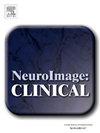Cerebrovascular longitudinal atlas: Changes in cerebral arteries in unruptured intracranial aneurysm patients followed with MRA
IF 3.6
2区 医学
Q2 NEUROIMAGING
引用次数: 0
Abstract
Background
Patterns of change in cerebrovascular (CV) morphology associated with aging are highly relevant to the incidence and progression of CV disease, particularly stroke. Intracranial aneurysms (IA), a leading cause of hemorrhagic stroke, are linked with factors such as blood flow, arterial stiffness, and inflammation that may also drive other changes in CV morphology. We worked with a cohort of longitudinally-imaged IA patients to construct the first longitudinal atlas of CV morphology and studied its relationship with disease.
Methods
110 IA patients, ranging from 19 to 84 years old at IA detection, were monitored using 3D magnetic resonance angiography (MRA) for a mean of 6.11 (2.60) years with 3.6 (1.3) scans per patient. Using 405 image studies, we applied a machine learning diffeomorphic shape analysis to construct a longitudinal atlas of the cerebral arteries which defined a general trajectory of CV morphological change vs. age. This was paired with a centerline analysis to verify changes in individual arteries.
Results
Patient characteristics influenced the speed of CV shape change (e.g. diabetes mellitus, faster, p = 0.016), while other factors mapped to older CV age (e.g. hypertension, p = 0.0004). In parallel, we found that groups including autosomal dominant polycystic kidney disease (p = 0.0004), sex (p = 0.005), smoking (p = 0.046), and IA growth (p = 0.020) shared CV morphology characteristics. The centerline analysis validated changes consistent with the longitudinal atlas.
Conclusion
A general CV trajectory of increasing artery length and tortuosity over a period of several decades was found. Although specific IA characteristics were not found to significantly affect this trajectory, these changes in the CV may contribute to increases in IA risk with aging. While our longitudinal findings were consistent with previous cross-sectional studies of individuals without IA, it remains to be determined whether the pattern of morphological change we observed is representative of aging within the general population. The model we developed provides a basis for integrating CV morphological change into understanding of aging and disease.

脑血管纵向图谱:颅内动脉瘤未破裂患者行MRA后脑动脉的变化
背景与衰老相关的脑血管(CV)形态学改变模式与心血管疾病,特别是中风的发病率和进展高度相关。颅内动脉瘤(IA)是出血性中风的主要原因,与血流、动脉僵硬和炎症等因素有关,这些因素也可能导致CV形态的其他变化。我们与一组纵向成像的IA患者一起构建了第一个CV形态纵向图谱,并研究了其与疾病的关系。方法使用3D磁共振血管造影(MRA)对110例IA患者进行监测,平均监测时间为6.11年(2.60年),每例患者扫描3.6次(1.3次)。利用405个图像研究,我们应用机器学习微分形态分析来构建脑动脉纵向图谱,该图谱定义了CV形态随年龄变化的一般轨迹。这与中心线分析相匹配,以验证个体动脉的变化。结果患者特征影响CV形状变化的速度(如糖尿病,p = 0.016),其他因素与CV年龄较大有关(如高血压,p = 0.0004)。同时,我们发现包括常染色体显性多囊肾病(p = 0.0004)、性别(p = 0.005)、吸烟(p = 0.046)和IA生长(p = 0.020)在内的组共享CV形态特征。中心线分析证实了与纵向图谱一致的变化。结论在几十年的时间里,血管长度和弯曲度呈增加趋势。虽然没有发现特定的IA特征对这一轨迹有显著影响,但CV的这些变化可能导致IA风险随着年龄的增长而增加。虽然我们的纵向研究结果与之前对没有IA的个体进行的横断面研究一致,但我们观察到的形态变化模式是否代表了一般人群的衰老,还有待确定。我们开发的模型为将CV形态变化整合到对衰老和疾病的理解中提供了基础。
本文章由计算机程序翻译,如有差异,请以英文原文为准。
求助全文
约1分钟内获得全文
求助全文
来源期刊

Neuroimage-Clinical
NEUROIMAGING-
CiteScore
7.50
自引率
4.80%
发文量
368
审稿时长
52 days
期刊介绍:
NeuroImage: Clinical, a journal of diseases, disorders and syndromes involving the Nervous System, provides a vehicle for communicating important advances in the study of abnormal structure-function relationships of the human nervous system based on imaging.
The focus of NeuroImage: Clinical is on defining changes to the brain associated with primary neurologic and psychiatric diseases and disorders of the nervous system as well as behavioral syndromes and developmental conditions. The main criterion for judging papers is the extent of scientific advancement in the understanding of the pathophysiologic mechanisms of diseases and disorders, in identification of functional models that link clinical signs and symptoms with brain function and in the creation of image based tools applicable to a broad range of clinical needs including diagnosis, monitoring and tracking of illness, predicting therapeutic response and development of new treatments. Papers dealing with structure and function in animal models will also be considered if they reveal mechanisms that can be readily translated to human conditions.
 求助内容:
求助内容: 应助结果提醒方式:
应助结果提醒方式:


